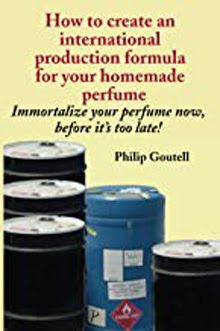* A muddy mountain bike on a foggy trail.
* A web golden retriever with a Frisbee in her mouth.
* A soccer ball in midair as it scores a goal.
Yes, we can imagine these smells but, to translate them into perfumes? Where do we start? How do we do it? It's not like we are going to start with a bottle of some existing fragrance oil. We have to make that oil, element by element. We have to build our perfume from the appropriate building blocks. We need real life examples to guide us. We need definitions.
Perfumery involves translating words into smells. We think, for the most part, in words. When we think of a new perfume we want to make, we define it -- in our heads -- in terms of common words and visual images and visual images can be defined in words.
To make perfume, those words must be translated into smells, defined by smells.
So what we need is a scent alphabet, a scent vocabulary, and a scent dictionary. Then we can translate an idea for a perfumes into a formula for that perfume -- and notice, without the formula we cannot make the perfume. You can't put a mountain bike (or a golden retriever) into a mixing pot. You have to reduce it (or her) -- the smell you want -- to a formula, and this means you have to define "mountain bike" or "wet golden retriever" in words that specify aroma materials in precise amounts. Once you learn to do this perfume making becomes incredibly exciting because all of the worlds around you -- both the physical and the mental -- become your palate for new perfumes.
You could spend a lifetime learning ... or --
A professional perfumer spends a lifetime learning these definitions. That is what makes creativity flow -- ideas become perfumes because the perfumer knows how that which is born in words can be translated into a formula for a fragrance.
But what about you? Or me? While our interest in perfume creation may be intense, the amount of time we devote to learning the use of hundreds of aroma materials is likely to be limited. Sure, we become quite familiar with the handful that we use most often, but we're not quite ready -- yet -- to create that "wet golden retriever" perfume because, while we think we know what it might smell like, our thoughts are still words and these words are not yet defined by precise combinations of aroma materials.
A table of definitions
The Perfumer's Workbook includes a table of definitions -- over 450 words and images (given in words) translated into aroma mixtures which you or I can mix -- and smell.
Think of it. 450 precise mixtures that define 450 words and word images. What an incredible starting point for fragrance creation! Think of what happens by using two words together -- over 20,000 fragrance definitions. Or three words together -- over 91 million definitions! Think how many perfumes -- perhaps now only dreams in your head -- you could make from this simple but precise table of definitions.
The Perfumer's Workbook serves many functions. Some are quite advanced, others simple. The formulas given in The Perfumer's Workbook table of definitions use only 26 aroma materials -- even for all 91 million 3-word definitions.
Both The Perfumer's Workbook and the 26 defining aroma materials are part of the PerfumersWorld Foundation Course. It's a pretty strong way to get started developing your own perfumes. It opens up an unlimited world of scents to you.
Subscribe to:
Post Comments (Atom)


It is a great fashion statement and a good professional look is given.
ReplyDeletePerfume Essence
Brand Fragrance oil